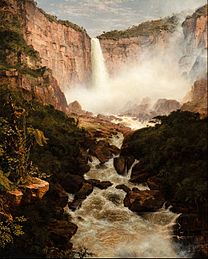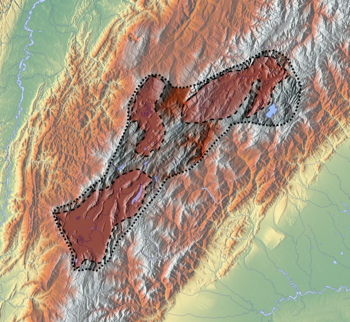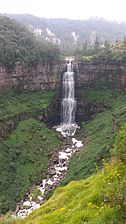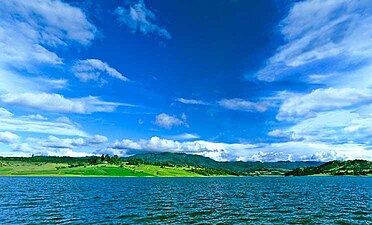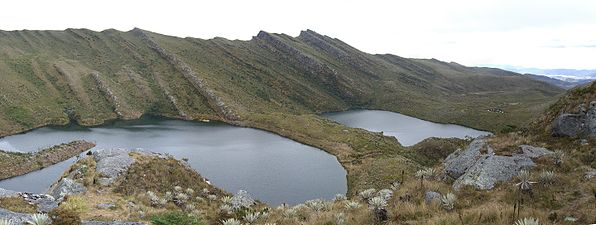
The Muisca are an indigenous people and culture of the Altiplano Cundiboyacense, Colombia, that formed the Muisca Confederation before the Spanish conquest. The people spoke Muysccubun, a language of the Chibchan language family, also called Muysca and Mosca. They were encountered by conquistadors dispatched by the Spanish Empire in 1537 at the time of the conquest. Subgroupings of the Muisca were mostly identified by their allegiances to three great rulers: the hoa, centered in Hunza, ruling a territory roughly covering modern southern and northeastern Boyacá and southern Santander; the psihipqua, centered in Muyquytá and encompassing most of modern Cundinamarca, the western Llanos; and the iraca, religious ruler of Suamox and modern northeastern Boyacá and southwestern Santander.

Guatavita is a municipality and town of Colombia in the Guavio Province of the department of Cundinamarca. Guatavita is located 75 km northeast of the capital Bogotá. It borders Sesquilé and Machetá in the north, Gachetá and Junín in the east, Guasca in the south and in the west are Tocancipá and Gachancipá.
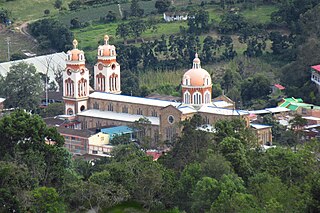
Ubaque is a municipality and town of Colombia in the Eastern Province of the department of Cundinamarca. Ubaque borders the municipalities Choachí in the north, Fómeque in the east, Cáqueza and Chipaque in the south and in the west is the Colombian capital Bogotá at 56 km away.
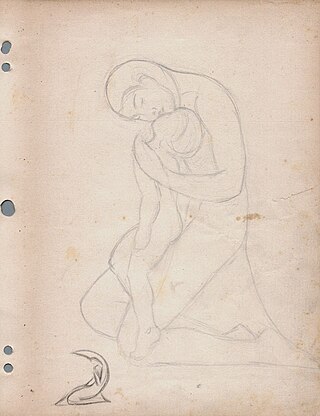
The terms Muisca religion and mythology refer to the pre-Columbian beliefs of the Muisca indigenous people of the Cordillera Oriental highlands of the Andes in the vicinity of Bogotá, Colombia. The tradition includes a selection of received myths concerning the origin and organization of the universe. Their belief system may be described as a polytheistic religion containing a very strong element of spirituality based on an epistemology of mysticism.

The Muisca Confederation was a loose confederation of different Muisca rulers in the central Andean highlands of present-day Colombia before the Spanish conquest of northern South America. The area, presently called Altiplano Cundiboyacense, comprised the current departments of Boyacá, Cundinamarca and minor parts of Santander.

Cuchavira or Cuchaviva is the rainbow deity, protector of working women and the sick in the religion of the Muisca. The Muisca and their confederation were one of the advanced civilizations of the Americas and in the fertile intermontane valley that forms the Altiplano Cundiboyacense in the Andes rain and sun were both very important for their agriculture. Moreover, in those days the Bogotá savanna consisted of various swamps and floodings were regular.

Huitaca or Xubchasgagua was a rebelling goddess in the religion of the Muisca. The Muisca and their confederation were a civilization who inhabited the Altiplano Cundiboyacense in the Andes. Huitaca has been described by the chroniclers Juan de Castellanos in his Elegías de varones ilustres de Indias, Lucas Fernández de Piedrahita and Pedro Simón.
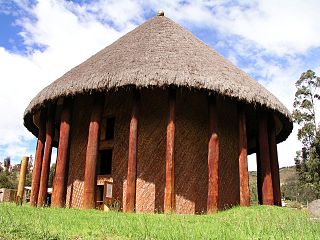
Chiminigagua, Chiminichagua or Chimichagua was the supreme being, omnipotent god and creator of the world in the religion of the Muisca. The Muisca and their confederation were one of the four advanced civilizations of the Americas and developed their own religion on the Altiplano Cundiboyacense in the Andes.

Sué, Xué, Sua, Zuhe or Suhé was the god of the Sun in the religion of the Muisca. He was married to Moon goddess Chía. The Muisca and their confederation were one of the four advanced civilizations of the Americas and developed their own religion on the Altiplano Cundiboyacense in the Andes. Both the Sun and rain, impersonated by Chibchacum, were very important for their agriculture.

Goranchacha was a mythical cacique who was said to have been the prophet of the Muisca of South America, in particular of the zacazgo of the northern Muisca Confederation. He is considered the son of the Sun, impersonated by the Sun god Sué.
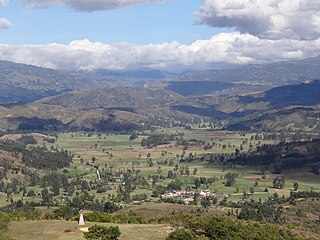
The iraca, sometimes spelled iraka, was the ruler and high priest of Sugamuxi in the confederation of the Muisca who inhabited the Altiplano Cundiboyacense; the central highlands of the Colombian Andes. Iraca can also refer to the Iraka Valley over which they ruled. Important scholars who wrote about the iraca were Lucas Fernández de Piedrahita, Alexander von Humboldt and Ezequiel Uricoechea.

The Cojines del Zaque is an archeological site of the Muisca located in the city of Tunja, Boyacá, which in the time of the Muisca Confederation was called Hunza. The cojines are two round stones used in the religion of the Muisca to worship Sun god Sué and his wife; Moon goddess Chía. When the Spanish conquistadores arrived, they called them Cojines del Diablo.

The Moon Temple of Chía was a temple constructed by the Muisca as a place of worship for their Moon goddess Chía. The temple was built in Chía, Cundinamarca, Colombia, then part of the Muisca Confederation. It was one of the most important temples in the religion of the Muisca. The temple was destroyed during the Spanish conquest of the Muisca on the Altiplano Cundiboyacense. Little is known about the temple built on the Tíquiza Hill in western Chía bordering Tabio.
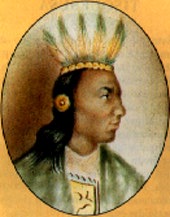
The Hunzahúa Well is an archeological site of the Muisca located in the city of Tunja, Boyacá, which in the time of the Muisca Confederation was called Hunza. The well is named after the first zaque of Hunza, Hunzahúa. The well was called Pozo de Donato for a while, after 17th century Jerónimo Donato de Rojas. The well is located on the campus of the Pedagogical and Technological University of Colombia in Tunja. Scholar Javier Ocampo López has written about the well and its mythology. Knowledge about the well has been provided by scholar Pedro Simón.

The Siecha Lakes are three glacial lakes located in the Chingaza Natural National Park in Cundinamarca, Colombia. The Andean lakes are considered sacred in the religion of the Muisca who inhabited the area before the Spanish conquest of the Muisca in the 1530s.

This article describes the architecture of the Muisca. The Muisca, inhabiting the central highlands of the Colombian Andes, were one of the four great civilizations of the Americas. Unlike the three civilizations in present-day Mexico and Peru, they did not construct grand architecture of solid materials. While specialising in agriculture and gold-working, cloths and ceramics, their architecture was rather modest and made of non-permanent materials as wood and clay.

This article describes the astronomy of the Muisca. The Muisca, one of the four advanced civilisations in the Americas before the Spanish conquest of the Muisca, had a thorough understanding of astronomy, as evidenced by their architecture and calendar, important in their agriculture.

This article describes the role of women in the society of the Muisca. The Muisca are the original inhabitants of the Altiplano Cundiboyacense before the Spanish conquest of the Muisca in the first half of the 16th century. Their society was one of the four great civilizations of the Americas.

The Goranchacha Temple is an archeological site of the Muisca located in the city of Tunja, Boyacá, which in the time of the Muisca Confederation was called Hunza. The temple is named after the mythological Goranchacha. The remains of the temple are located on the terrain of the Pedagogical and Technological University of Colombia in Tunja. Scholar Javier Ocampo López has written about the temple and its religious meaning. Knowledge about the temple has been provided by chronicler Pedro Simón.

This article describes the art produced by the Muisca. The Muisca established one of the four grand civilisations of the pre-Columbian Americas on the Altiplano Cundiboyacense in present-day central Colombia. Their various forms of art have been described in detail and include pottery, textiles, body art, hieroglyphs and rock art. While their architecture was modest compared to the Inca, Aztec and Maya civilisations, the Muisca are best known for their skilled goldworking. The Museo del Oro in the Colombian capital Bogotá houses the biggest collection of golden objects in the world, from various Colombian cultures including the Muisca.





